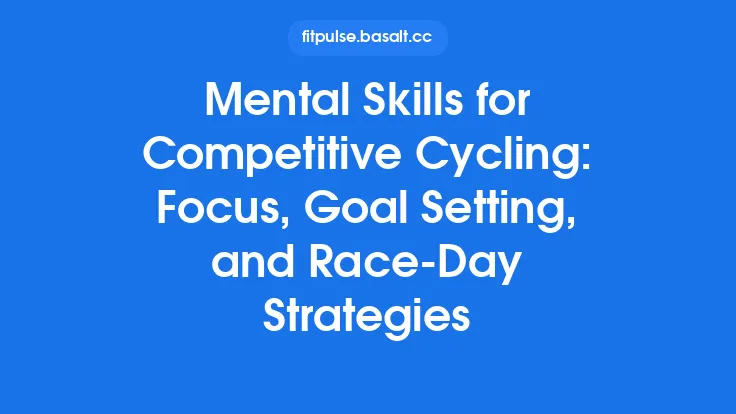Powerlifting is as much a mental endeavor as it is a physical one. While the barbell, plates, and training log are tangible tools, the mindset that drives consistent progress often determines whether an athlete reaches the podium or stalls at the gym. Developing a robust mental framework and setting purposeful goals lay the foundation for long‑term success, helping lifters stay motivated, navigate setbacks, and perform at their best when the weight is on the line.
The Psychology of Strength: Why Mental Preparation Matters
1. The Brain‑Muscle Connection
Neuroscience shows that the central nervous system (CNS) governs force production. When a lifter visualizes a heavy lift, motor neurons fire in a pattern similar to the actual movement, priming the muscles for the upcoming effort. This “neural priming” can improve bar speed, reduce hesitation, and increase confidence—especially in maximal attempts.
2. Stress, Arousal, and Performance
The Yerkes‑Dodson law describes an inverted‑U relationship between arousal and performance. Too little arousal leads to under‑engagement, while excessive stress can cause tremors, poor technique, and premature fatigue. Mental preparation aims to place the athlete in the optimal arousal zone, where focus is sharp and anxiety is manageable.
3. Resilience and Long‑Term Consistency
Powerlifting cycles often span months or years, with inevitable plateaus, injuries, and life‑event interruptions. A resilient mindset—cultivated through deliberate mental training—helps athletes view setbacks as data points rather than failures, preserving motivation over the long haul.
Crafting Effective Goals: From Vision to Execution
1. The SMART Framework
- Specific – Define the exact lift, weight, and context (e.g., “Squat 315 lb in the next meet”).
- Measurable – Ensure progress can be quantified (weight, reps, or percentage of 1RM).
- Achievable – Set a realistic target based on current training age and baseline.
- Relevant – Align the goal with broader aspirations (e.g., moving up a weight class).
- Time‑Bound – Attach a deadline (competition date, training block end).
2. Process vs. Outcome Goals
- Outcome Goals focus on the end result (e.g., “Place top‑3 at the state championship”).
- Process Goals concentrate on controllable actions (e.g., “Complete three weekly technique drills before each squat session”).
Balancing both types ensures athletes stay motivated by the journey while keeping an eye on the ultimate prize.
3. Hierarchical Goal Structuring
Break long‑term ambitions into medium‑ and short‑term milestones. For example:
| Level | Example |
|---|---|
| Long‑Term | “Compete in a national meet within 24 months.” |
| Mid‑Term | “Increase deadlift 1RM by 20 lb over the next 12 weeks.” |
| Short‑Term | “Add 5 lb to the weekly deadlift progression for the next three sessions.” |
This hierarchy creates a clear roadmap, allowing athletes to celebrate incremental wins and maintain momentum.
Mental Skills Training Techniques
1. Visualization and Mental Rehearsal
Spend 5–10 minutes daily picturing successful lifts: the setup, the cue, the bar’s trajectory, and the feeling of completion. Research indicates that vivid, multisensory imagery activates the same neural pathways as physical execution, enhancing motor learning and confidence.
2. Self‑Talk Strategies
- Instructional Self‑Talk (“Drive through the heels, keep the chest up”) is useful during skill acquisition.
- Motivational Self‑Talk (“I’ve got this, stay strong”) helps sustain effort during high‑intensity sets.
Practice both forms in training to develop a repertoire that can be deployed in competition.
3. Pre‑Performance Routines
A consistent ritual—such as a specific warm‑up sequence, a breathing pattern, or a cue word—signals the brain that it’s time to perform. Over time, the routine becomes a conditioned stimulus that triggers focus and reduces anxiety.
4. Controlled Breathing and Relaxation
Box breathing (4‑4‑4‑4) or diaphragmatic breathing lowers heart rate and mitigates sympathetic nervous system activation. Incorporate a brief breathing session before heavy attempts to settle the nervous system and sharpen concentration.
5. Goal‑Focused Journaling
Maintain a mental‑training log alongside the physical training log. Record daily reflections on mood, confidence levels, and mental obstacles. Periodic review reveals patterns (e.g., confidence dips after certain training loads) and informs adjustments to mental strategies.
Managing Setbacks: A Structured Approach
1. Reframe the Narrative
Instead of labeling a missed lift as “failure,” view it as “feedback.” Ask: What did the CNS tell me? Which technical cue was off? This reframing reduces emotional charge and encourages analytical problem‑solving.
2. The “Three‑Step Recovery” Model
- Acknowledge – Accept the setback without judgment.
- Analyze – Identify contributing factors (training load, sleep, nutrition, stress).
- Adjust – Implement a concrete change (e.g., add an extra recovery day, modify mental rehearsal length).
3. Building a Support Network
Coaches, training partners, and sports psychologists can provide perspective, accountability, and emotional support. Regular check‑ins help keep mental health in balance, especially during injury rehab or competition slumps.
Integrating Mental Preparation into the Training Cycle
1. Macro‑Cycle Planning
Allocate dedicated mental‑training blocks within the overall periodization plan. For example, during a 12‑week strength block, schedule:
- Weeks 1‑4: Emphasis on process goals and skill acquisition; introduce visualization drills.
- Weeks 5‑8: Shift to outcome goals; increase intensity of self‑talk and pre‑performance routines.
- Weeks 9‑12: Taper mental load; focus on relaxation, confidence building, and competition simulation.
2. Micro‑Cycle Implementation
Within each weekly training plan, embed short mental‑skill sessions:
| Day | Physical Focus | Mental Focus |
|---|---|---|
| Monday | Heavy squat + accessories | Visualization of squat setup |
| Wednesday | Bench press volume | Self‑talk practice during sets |
| Friday | Deadlift max effort | Pre‑performance routine rehearsal |
| Saturday | Active recovery | Journaling and breathing exercises |
3. Monitoring Mental Metrics
Just as you track volume and intensity, record mental indicators such as:
- Confidence Rating (1‑10) before each major lift.
- Arousal Level (1‑10) using a simple Likert scale.
- Focus Duration (seconds of uninterrupted concentration during a set).
Plotting these alongside performance data can reveal correlations and guide future adjustments.
Competition Mindset: Translating Training Mentality to the Platform
1. Simulated Competition Sessions
Periodically conduct “mock meets” where you follow official timing, attempt three lifts per movement, and adhere to competition rules. Treat the session as a real meet to practice mental routines under pressure.
2. Cue Hierarchy on the Platform
Develop a concise set of cues (e.g., “Chest up → Drive” for the bench) that can be quickly recalled amidst crowd noise. Prioritize cues that trigger the most reliable motor patterns.
3. Managing External Distractions
- Noise: Use earplugs or focus on a fixed point in the arena.
- Crowd Energy: Channel the adrenaline into controlled aggression rather than letting it cause premature tension.
- Time Delays: Practice staying warm and mentally engaged during extended waiting periods between attempts.
4. Post‑Attempt Reflection
Immediately after each lift, note a brief mental snapshot: What worked? What felt off? This rapid debrief helps adjust the next attempt without over‑thinking, preserving flow.
Building a Sustainable Mental Edge
1. Habit Formation Principles
Anchor new mental practices to existing training habits. For instance, pair a 2‑minute breathing exercise with the final warm‑up set of every session. Consistency turns the practice into an automatic part of the routine.
2. Periodic Mental “Deload”
Just as physical deload weeks reduce physiological stress, schedule mental deload weeks where you lower the intensity of mental training (e.g., shorter visualizations, reduced journaling) to prevent burnout.
3. Lifelong Learning and Adaptation
The mental game evolves with experience. Stay curious—read sports psychology literature, attend workshops, or work with a mental performance coach. Continual learning ensures your mental toolkit remains sharp as your lifting capacity grows.
Final Thoughts
Success in powerlifting hinges on the seamless integration of body and mind. By establishing clear, structured goals, cultivating proven mental‑training techniques, and embedding these practices into every phase of the training cycle, lifters can enhance focus, boost confidence, and navigate the inevitable ups and downs of the sport. A disciplined mental approach not only elevates performance on the platform but also fosters resilience, enjoyment, and longevity in the pursuit of strength.




